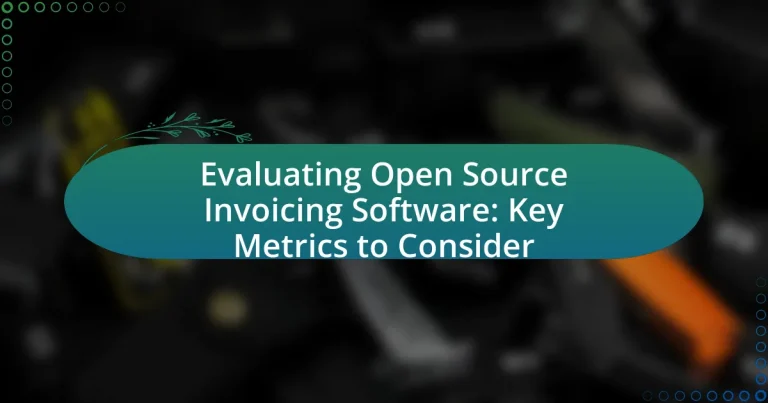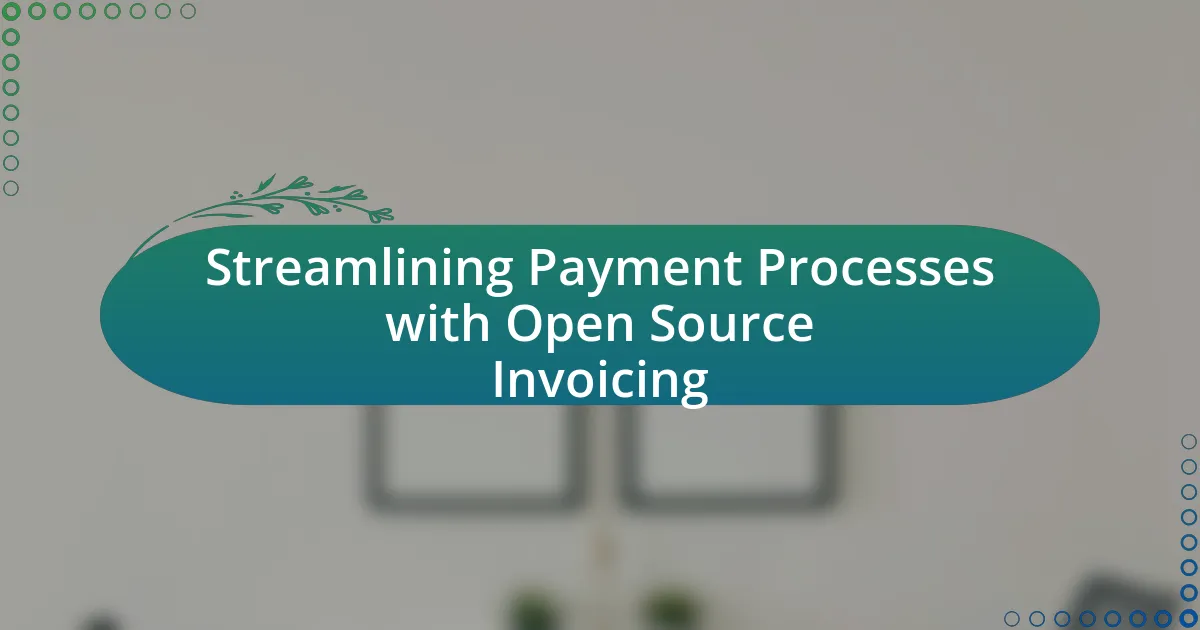Open Source Invoicing Software refers to invoicing applications with publicly available source code, allowing users to create, manage, and send invoices without licensing fees. This article evaluates key metrics for selecting such software, including functionality, user interface, community support, security features, and integration capabilities. It highlights the differences between open source and proprietary solutions, emphasizing cost benefits, customization options, and the importance of user experience. Additionally, the article discusses best practices for implementation and maintenance, as well as the role of community engagement in enhancing software security and performance.

What is Open Source Invoicing Software?
Open Source Invoicing Software is a type of invoicing application whose source code is made publicly available for anyone to use, modify, and distribute. This software allows businesses to create, manage, and send invoices without the licensing fees associated with proprietary software. Open source invoicing solutions often foster community collaboration, leading to continuous improvements and updates, which can enhance functionality and security. Examples of popular open source invoicing software include Invoice Ninja and Dolibarr, which provide customizable features that cater to various business needs.
How does Open Source Invoicing Software differ from proprietary solutions?
Open Source Invoicing Software differs from proprietary solutions primarily in terms of accessibility and customization. Open source software allows users to access and modify the source code, enabling tailored features and functionalities to meet specific business needs, while proprietary solutions restrict access to the source code, limiting customization options. According to a 2021 survey by the Open Source Initiative, 78% of businesses using open source software reported improved flexibility and adaptability compared to proprietary alternatives. This flexibility often leads to lower costs, as open source solutions typically do not require licensing fees, whereas proprietary software can incur significant ongoing expenses for licenses and support.
What are the key features of Open Source Invoicing Software?
Key features of Open Source Invoicing Software include customizable templates, multi-currency support, automated billing, expense tracking, and integration capabilities with other software. Customizable templates allow users to tailor invoices to their branding needs, while multi-currency support facilitates international transactions. Automated billing features streamline recurring payments, and expense tracking helps businesses manage costs effectively. Integration capabilities with accounting and payment processing systems enhance overall functionality, making these software solutions versatile for various business needs.
How is the software licensed and what implications does this have?
The software is typically licensed under open-source licenses, which allow users to freely use, modify, and distribute the software. This licensing model promotes collaboration and innovation, as it enables developers to build upon existing code. For example, licenses like the GNU General Public License (GPL) require that any derivative works also remain open-source, ensuring that improvements benefit the community. Conversely, permissive licenses like the MIT License allow for proprietary use, which can lead to commercial exploitation without contributing back to the community. The implications of these licensing choices affect user rights, software sustainability, and the overall ecosystem of development, influencing how businesses and developers engage with the software.
Why should businesses consider Open Source Invoicing Software?
Businesses should consider Open Source Invoicing Software because it offers cost savings, flexibility, and customization options. Open source solutions eliminate licensing fees, allowing companies to allocate resources more efficiently. Additionally, these platforms can be tailored to meet specific business needs, enhancing functionality and user experience. According to a 2021 report by the Open Source Initiative, 78% of businesses using open source software reported improved innovation and adaptability, demonstrating the tangible benefits of adopting such solutions.
What are the cost benefits of using Open Source Invoicing Software?
Open Source Invoicing Software significantly reduces costs by eliminating licensing fees associated with proprietary software. Businesses can access and modify the software without incurring expenses for each user or installation, leading to substantial savings. According to a study by the European Commission, open source solutions can save organizations up to 30% in software costs compared to proprietary alternatives. Additionally, the flexibility of open source software allows companies to tailor the invoicing system to their specific needs without the costs of customization typically charged by commercial vendors. This adaptability further enhances cost efficiency, making open source invoicing software a financially advantageous choice for many businesses.
How does Open Source Invoicing Software enhance customization options?
Open Source Invoicing Software enhances customization options by allowing users to modify the source code to meet specific business needs. This flexibility enables businesses to tailor features, user interfaces, and workflows according to their unique requirements. For instance, companies can integrate additional functionalities such as payment gateways or reporting tools that are not available in standard solutions. The ability to access and alter the code ensures that organizations can adapt the software as their needs evolve, leading to improved efficiency and user satisfaction.

What key metrics should be evaluated when choosing Open Source Invoicing Software?
When choosing Open Source Invoicing Software, key metrics to evaluate include functionality, user interface, community support, security features, and integration capabilities. Functionality refers to the software’s ability to meet invoicing needs, such as generating invoices, tracking payments, and managing customer data. User interface assesses how intuitive and user-friendly the software is, impacting user adoption and efficiency. Community support indicates the availability of resources, forums, and documentation, which can enhance troubleshooting and software updates. Security features are crucial for protecting sensitive financial data, including encryption and compliance with regulations. Lastly, integration capabilities determine how well the software can connect with other tools and systems, facilitating seamless workflows. Evaluating these metrics ensures that the chosen software aligns with business requirements and enhances operational efficiency.
How can user experience impact the effectiveness of Open Source Invoicing Software?
User experience significantly impacts the effectiveness of Open Source Invoicing Software by influencing user adoption and satisfaction. A positive user experience leads to higher engagement, as users are more likely to utilize features effectively when the interface is intuitive and user-friendly. Research indicates that software with a well-designed user interface can increase productivity by up to 50%, as users spend less time navigating and more time completing tasks. Furthermore, user feedback on experience can drive continuous improvement in open source projects, enhancing functionality and addressing pain points, which ultimately leads to better overall performance and user retention.
What usability features should be prioritized in Open Source Invoicing Software?
Open Source Invoicing Software should prioritize user-friendly interfaces, customizable templates, and multi-currency support. User-friendly interfaces enhance accessibility, allowing users to navigate the software easily, which is crucial for efficiency. Customizable templates enable businesses to tailor invoices to their branding needs, improving professionalism and customer experience. Multi-currency support is essential for businesses operating internationally, as it simplifies transactions and reduces errors. According to a survey by Software Advice, 70% of users prefer software that offers customization options, highlighting the importance of these features in enhancing usability.
How does user feedback influence software improvements?
User feedback directly influences software improvements by providing developers with insights into user experiences and needs. This feedback helps identify bugs, usability issues, and feature requests, which can guide the development process. For instance, a study by the Nielsen Norman Group found that user feedback can lead to a 50% reduction in usability problems when incorporated into design iterations. By analyzing user comments and suggestions, developers can prioritize enhancements that align with user expectations, ultimately leading to a more effective and user-friendly software product.
What security considerations are important for Open Source Invoicing Software?
Security considerations for Open Source Invoicing Software include code review, vulnerability management, and data encryption. Code review ensures that the software is free from malicious code and security flaws, as open-source projects allow anyone to inspect and contribute to the codebase. Vulnerability management is crucial, as it involves regularly updating the software to patch known security vulnerabilities; for instance, the Common Vulnerabilities and Exposures (CVE) database tracks vulnerabilities that can affect open-source software. Data encryption protects sensitive information, such as customer payment details, during transmission and storage, adhering to standards like AES (Advanced Encryption Standard) to ensure confidentiality and integrity.
How can vulnerabilities be identified and mitigated in Open Source Software?
Vulnerabilities in Open Source Software can be identified through code reviews, automated security scanning tools, and community reporting. Code reviews involve examining the source code for security flaws, while automated tools like static analysis can detect common vulnerabilities such as buffer overflows or SQL injection. Community reporting allows users to report issues, which can lead to quicker identification of vulnerabilities.
Mitigation strategies include applying patches, implementing security best practices during development, and conducting regular security audits. Patching involves updating the software to fix known vulnerabilities, while security best practices, such as input validation and proper authentication, help prevent new vulnerabilities from being introduced. Regular security audits ensure ongoing compliance with security standards and help identify any new vulnerabilities that may arise.
According to the Open Web Application Security Project (OWASP), regular updates and community engagement are critical for maintaining the security of Open Source Software, as they help ensure that vulnerabilities are addressed promptly and effectively.
What role does community support play in maintaining security?
Community support plays a crucial role in maintaining security by fostering collaboration and vigilance among users. When individuals actively engage in discussions, share experiences, and report vulnerabilities, they contribute to a collective knowledge base that enhances the security of the software. For instance, open-source projects often rely on community members to identify and patch security flaws, as seen in the case of the OpenSSL project, where community contributions led to the rapid identification and resolution of critical vulnerabilities. This collaborative approach not only accelerates the response to security threats but also builds trust within the community, ensuring that users feel empowered to contribute to the ongoing security of the software.

How can businesses effectively implement Open Source Invoicing Software?
Businesses can effectively implement Open Source Invoicing Software by following a structured approach that includes assessing their specific invoicing needs, selecting the appropriate software, customizing it to fit their workflows, and training staff on its use. First, businesses should evaluate their invoicing requirements, such as the volume of invoices, integration with existing systems, and specific features needed, which ensures that the chosen software aligns with operational goals. Next, selecting software that has a strong community support and regular updates, such as Invoice Ninja or Odoo, can enhance reliability and security. Customization is crucial; businesses should tailor the software to their processes, which can improve efficiency and user adoption. Finally, providing comprehensive training for employees on how to use the software effectively can lead to smoother implementation and better utilization of its features. This structured approach is supported by case studies showing that businesses that invest time in these steps experience higher satisfaction and efficiency with open source solutions.
What steps should be taken for a successful implementation?
To achieve successful implementation of open source invoicing software, organizations should follow these steps: first, conduct a thorough needs assessment to identify specific requirements and objectives. This ensures that the selected software aligns with business goals. Next, choose the right software by evaluating various options based on features, community support, and compatibility with existing systems. After selection, develop a detailed implementation plan that includes timelines, resource allocation, and training for users.
Subsequently, execute the plan by installing the software, configuring settings, and migrating existing data. It is crucial to involve stakeholders throughout the process to gather feedback and make necessary adjustments. Finally, establish a support system for ongoing maintenance and updates, ensuring that the software remains effective and secure. These steps are validated by industry best practices, which emphasize the importance of planning, stakeholder engagement, and continuous support in software implementation success.
How can training be structured for users of Open Source Invoicing Software?
Training for users of Open Source Invoicing Software can be structured through a combination of hands-on workshops, online tutorials, and comprehensive documentation. Hands-on workshops allow users to engage directly with the software, facilitating practical understanding of its features and functionalities. Online tutorials provide flexible learning options, enabling users to learn at their own pace, while comprehensive documentation serves as a reference guide for troubleshooting and advanced features. This structured approach ensures that users gain both theoretical knowledge and practical skills, enhancing their ability to effectively utilize the software.
What common challenges might arise during implementation?
Common challenges that might arise during the implementation of open source invoicing software include integration issues, user training, and data migration difficulties. Integration issues occur when the new software does not seamlessly connect with existing systems, leading to operational disruptions. User training is often inadequate, resulting in staff not fully utilizing the software’s features, which can hinder productivity. Data migration difficulties arise when transferring existing financial data into the new system, potentially leading to data loss or inaccuracies. These challenges are frequently reported in case studies and user feedback, highlighting the importance of thorough planning and support during the implementation process.
What are best practices for maintaining Open Source Invoicing Software?
Best practices for maintaining Open Source Invoicing Software include regular updates, active community engagement, thorough documentation, and robust security measures. Regular updates ensure that the software remains compatible with the latest technologies and addresses any bugs or vulnerabilities, which is crucial as 60% of open-source vulnerabilities are found in outdated software. Active community engagement fosters collaboration and innovation, as seen in successful projects like WordPress, where community contributions significantly enhance functionality. Thorough documentation aids users and developers in understanding the software, which is essential for effective maintenance and user adoption. Lastly, implementing robust security measures, such as regular security audits and adherence to best coding practices, is vital, given that 70% of organizations report security issues with open-source software.
How often should updates and maintenance be performed?
Updates and maintenance should be performed at least once a month for open source invoicing software. Regular monthly updates help ensure that the software remains secure, functional, and compatible with other systems. According to the National Institute of Standards and Technology (NIST), timely updates are crucial for mitigating vulnerabilities, as 60% of breaches exploit known vulnerabilities that could have been patched. Therefore, adhering to a monthly schedule for updates and maintenance is essential for optimal performance and security.
What resources are available for troubleshooting and support?
For troubleshooting and support related to open source invoicing software, users can access several resources. These include official documentation, community forums, and user guides provided by the software developers. Official documentation typically contains detailed instructions and troubleshooting steps, while community forums allow users to share experiences and solutions. Additionally, many open source projects have dedicated support channels, such as GitHub repositories, where users can report issues and receive assistance from both developers and other users. These resources are essential for resolving common problems and enhancing user experience with the software.
What tips can help businesses maximize the benefits of Open Source Invoicing Software?
To maximize the benefits of Open Source Invoicing Software, businesses should prioritize customization, community engagement, and regular updates. Customization allows businesses to tailor the software to their specific invoicing needs, enhancing usability and efficiency. Engaging with the community can provide valuable insights, support, and shared resources, which can lead to improved software performance and innovation. Regular updates ensure that the software remains secure and incorporates the latest features, which is crucial for maintaining operational effectiveness. These strategies collectively enhance the overall utility and effectiveness of Open Source Invoicing Software for businesses.




